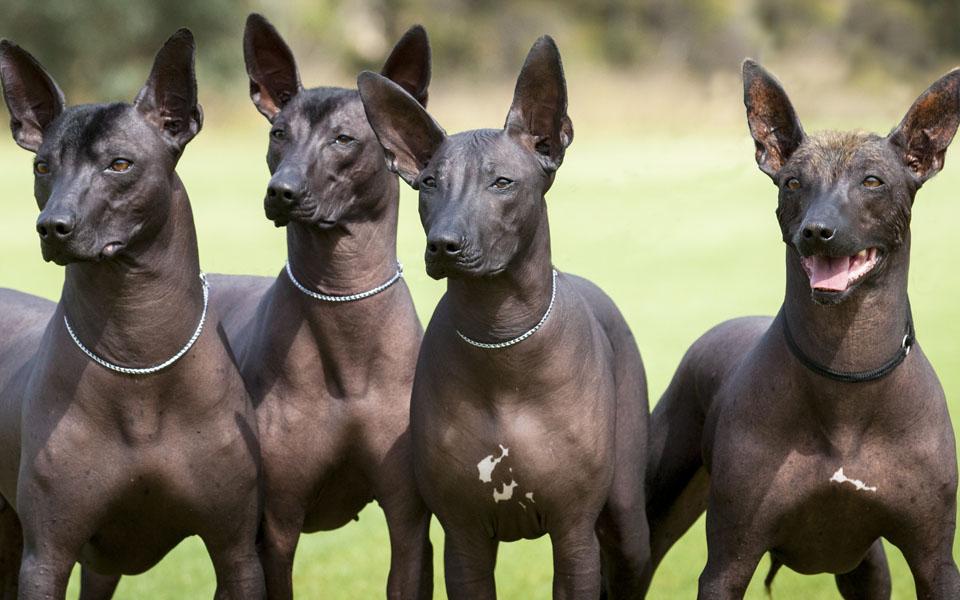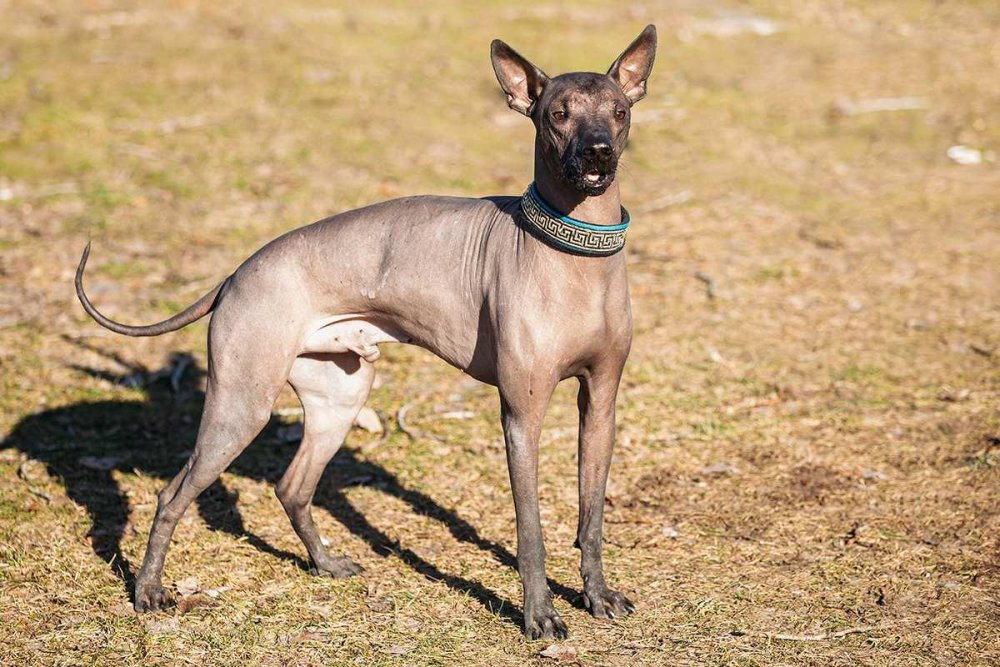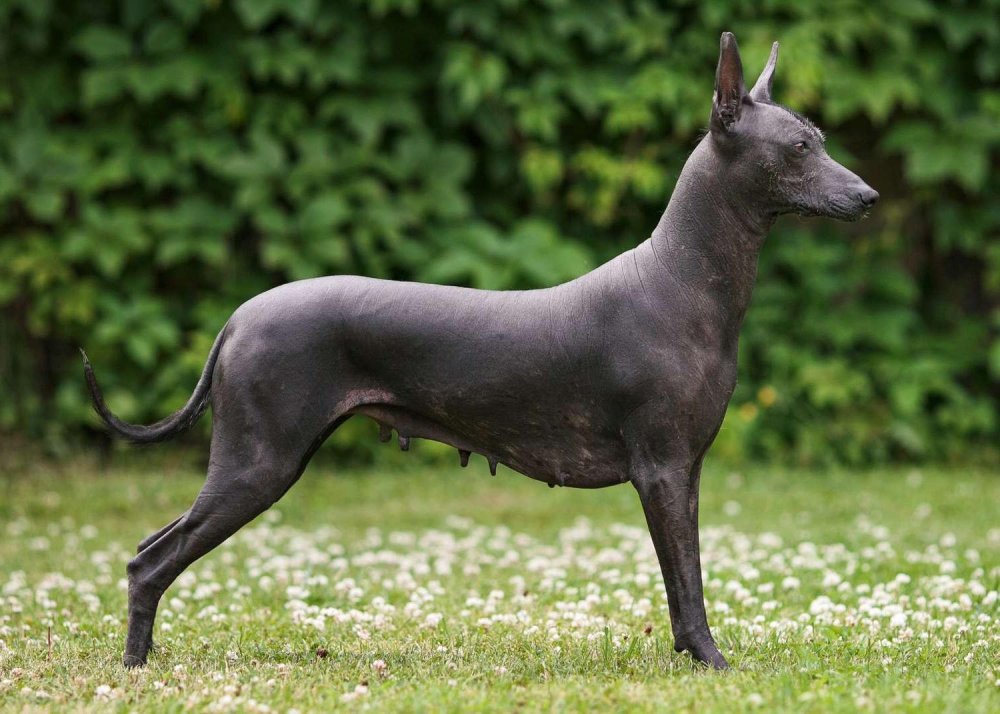- Breed Category: Companion, Primitive
- Country of Origin: Mexico
- Average Height: 46-60 cm (18-24 in)
- Average Weight: 9-18 kg (20-40 lbs)
- Average Life Span: 12-15 years
- Grooming Requirements: Low, occasional baths
- Exercise Requirements: Moderate, daily walks
- Coat Type: Hairless or short-coated
- Coat Color Variations: Black, grey, bronze
- Shedding Level: Minimal
- Ear Type: Erect
- Tail Type: Long, tapering
- Temperament: Loyal, alert, calm
- Intelligence Level: High
- Barking Tendency: Low
- Compatibility with Children: Good with proper socialisation
- Compatibility with Other Pets: Generally good
- Training Ease: Moderate, requires consistency
- Common Health Issues: Skin issues, dental problems
- Dietary Needs: Balanced, high-quality diet
- Energy Level: Moderate
- Drooling Tendency: Low
- Sensitivity to Weather: High, needs protection
- Overall Maintenance Level: Low to moderate
- Original Purpose: Companion, guard dog
- Year of Recognition by Kennel Clubs: 2011 (AKC)
- Apartment Friendly: Yes, with sufficient exercise
- Best Suited For: Families, active individuals
- Cost of Ownership: Moderate
- Unique Traits: Hairless, ancient breed
- Cultural Significance: Sacred in Aztec culture
Imagine a dog that’s as ancient as the pyramids, yet as lively as a pup in the park. Meet the Xoloitzcuintle, or Xolo for short. This breed, with its sleek, hairless body and soulful eyes, has been a companion to humans for over 3,000 years. Originating from Mexico, the Xolo is not just a pet; it’s a piece of living history. Known for their calm temperament and keen intelligence, these dogs are both guardians and friends. This article will delve into the unique characteristics of the Xoloitzcuintle, explore its rich history, and provide insights into caring for this remarkable breed. Whether you’re a seasoned dog owner or new to the world of canines, the Xolo offers something truly special.
History and Cultural Significance of the Xoloitzcuintle

Ancient Roots in Mexico
The Xoloitzcuintle, often simply called the Xolo, traces its lineage back to ancient Mexico. These dogs were companions to the Aztecs, Toltecs, and Maya, revered not just as pets but as sacred animals. Their history is intertwined with mythology, believed to guide souls to the afterlife. This deep-rooted connection to ancient civilisations makes the Xolo a living relic of the past.
Cultural Significance and Historical Roles
Throughout history, the Xolo has played various roles in Mexican culture. They were considered healers, with their warm bodies providing comfort and relief from ailments. In rural communities, they served as vigilant guardians, protecting homes from intruders. Their presence in rituals and ceremonies highlights their spiritual importance, a testament to their revered status.
Revival and Preservation Efforts
In modern times, the Xoloitzcuintle has experienced a revival. Efforts to preserve this ancient breed have intensified, with enthusiasts and breeders working to maintain its unique characteristics. Today, the Xolo is celebrated not only for its historical significance but also for its adaptability and charm, making it a cherished companion in homes around the world.
Physical Characteristics of the Xoloitzcuintle

Appearance
The Xoloitzcuintle comes in three sizes: toy, miniature, and standard. This variety means there’s a Xolo for every type of home, whether you live in a cosy apartment or a sprawling house. Their skin is smooth and comes in a range of colours, from black to slate, bronze, and even red. Some Xolos have a short, sleek coat, while others are completely hairless, showcasing their unique and striking appearance.
Unique Physical Traits
One of the most distinctive features of the Xolo is its hairless variety, which is not only eye-catching but also hypoallergenic, making it a great choice for those with allergies. The coated variety, though less common, has a short, flat coat that’s easy to maintain. Both types have a noble, elegant look, with almond-shaped eyes that seem to hold centuries of wisdom.
Temperament and Behaviour
Xolos are known for their calm and gentle nature. They’re incredibly loyal and form strong bonds with their families. While they can be reserved with strangers, they’re affectionate and playful with those they trust. These dogs are intelligent and alert, making them excellent watchdogs. Despite their ancient roots, they adapt well to modern living, thriving in both active and relaxed environments.
Personality and Suitability as a Family Pet

Typical Personality Traits
The Xoloitzcuintle is a breed that stands out for its loyalty and intelligence. These dogs are known for their calm demeanour, making them a soothing presence in any household. They are quick learners, often picking up commands and routines with ease. This intelligence, paired with their loyalty, makes them reliable companions who are always eager to please their owners.
Suitability as a Family Pet
As a family pet, the Xolo is a fantastic choice. Their calm nature means they adapt well to various living situations, whether it’s a bustling family home or a quieter environment. They thrive on companionship and are happiest when they are part of family activities. Their loyalty ensures they are protective, yet gentle, making them a great fit for families.
Interaction with Children and Other Animals
Xolos are generally good with children, displaying patience and playfulness. They enjoy engaging in games and activities, making them wonderful playmates for kids. When it comes to other animals, Xolos can coexist peacefully, especially if they are socialised from a young age. Their calm and composed nature helps them get along with other pets, creating a harmonious household.
Training and Exercise Needs of the Xoloitzcuintle

Importance of Early Training and Socialisation
Getting a Xoloitzcuintle off to a good start with early training and socialisation is crucial. These dogs are naturally intelligent and curious, so introducing them to different environments, people, and other animals early on helps them grow into well-rounded adults. This early exposure reduces the chances of them becoming overly shy or anxious.
Recommended Training Techniques
When it comes to training, positive reinforcement is the way to go. Xolos respond well to treats, praise, and play as rewards. Consistency is key, so short, regular training sessions work best. They’re quick learners, so keeping the sessions engaging and varied will hold their interest and make training a fun experience for both of you.
Daily Exercise Requirements and Activities They Enjoy
Xolos are active dogs that need daily exercise to stay happy and healthy. A good mix of walks, playtime, and mental stimulation is ideal. They enjoy activities like fetch, agility courses, and even a good romp in the backyard. Regular exercise not only keeps them fit but also strengthens the bond between you and your Xolo.
Health and Lifespan of the Xoloitzcuintle

Common Health Issues
The Xoloitzcuintle is generally a healthy breed, but like all dogs, they can be prone to certain health issues. Skin problems are the most common, especially in the hairless variety. Regular skin care is essential to prevent dryness and irritation. Dental health is another area to watch, as they can be susceptible to gum disease.
Average Lifespan and Health Tips
With proper care, a Xolo can live between 12 to 15 years. To keep them healthy, a balanced diet and regular exercise are crucial. Their skin needs protection from the sun, so applying dog-safe sunscreen is a good idea. Regular vet check-ups will help catch any potential issues early.
Preventative Care Recommendations
- Regular dental cleanings to prevent gum disease.
- Monthly skin checks to catch any irritations or infections early.
- Annual vet visits for vaccinations and health screenings.
- Consistent flea and tick prevention, especially if they spend time outdoors.
Grooming and Maintenance of the Xoloitzcuintle

Coat Care and Grooming Routines
For the Xoloitzcuintle, grooming varies between the hairless and coated varieties. Hairless Xolos need regular skin care to keep their skin healthy and free from irritation. A gentle bath every couple of weeks with a mild dog shampoo is usually enough. For the coated variety, a quick brush once a week will keep their short coat looking sleek and tidy.
Skin Care Tips for Hairless Xoloitzcuintles
Hairless Xolos require special attention to their skin. Moisturising is key to prevent dryness, so use a dog-safe lotion regularly. Sun protection is also important; applying a dog-friendly sunscreen before outdoor activities can help avoid sunburn. Regular checks for any signs of irritation or infection are essential to maintain healthy skin.
Diet and Nutrition
A balanced diet is crucial for the Xoloitzcuintle’s overall health. High-quality dog food that meets their nutritional needs will support their active lifestyle. It’s important to monitor their weight and adjust portions as needed to prevent obesity. Fresh water should always be available, and occasional treats can be used for training and rewards.
Nutritional Needs for Optimal Health
Foods to Include and Avoid
Feeding your Xoloitzcuintle a balanced diet is key to their health and vitality. Opt for high-quality dog food rich in protein, healthy fats, and essential vitamins. Look for ingredients like chicken, fish, or lamb, which provide the necessary nutrients for their active lifestyle. Avoid foods with artificial additives, fillers, or excessive grains, as these can lead to allergies or digestive issues.
Feeding Schedules and Portion Recommendations
Establishing a consistent feeding schedule helps maintain your Xolo’s energy levels and prevents overeating. Typically, two meals a day—morning and evening—work well for adult Xolos. Puppies may require more frequent meals. Portion sizes depend on their size and activity level, so it’s important to follow the guidelines on your chosen dog food and adjust as needed. Always ensure fresh water is available to keep them hydrated.
Fun Facts and Trivia about the Xoloitzcuintle

Interesting Tidbits about the Breed
The Xoloitzcuintle, often called the Xolo, is one of the oldest and rarest dog breeds in the world. With a history that dates back over 3,000 years, these dogs were considered sacred by ancient civilisations like the Aztecs and Maya. They believed Xolos had healing powers and could ward off evil spirits. This breed is also known for its unique hairless variety, which is not only striking but also hypoallergenic, making it a great choice for allergy sufferers.
Famous Xoloitzcuintles in Media or History
Xolos have made their mark in both history and popular culture. Frida Kahlo, the renowned Mexican artist, was a famous Xolo owner, often featuring them in her paintings. In the world of cinema, the Xolo gained fame as Dante, the loyal companion in Disney’s “Coco,” which brought attention to this ancient breed. Their unique appearance and rich history make them a fascinating subject in both art and film.
Final Thoughts

The Xoloitzcuintle is a living testament to ancient history. This remarkable breed combines a rich cultural heritage with modern-day adaptability, making it a unique and cherished companion. With its loyal temperament and minimal grooming needs, the Xolo offers both challenges and rewards for dedicated owners. Embracing a Xolo means preserving a piece of history while enjoying a loyal, intelligent friend. Consider welcoming this extraordinary breed into your life and experience the joy of a truly special canine companion.
